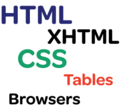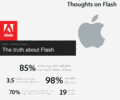Graphic Design

Coding Your Web Site with Quality
When you're ready to turn your beautiful design into a live, functioning web site, you need to tread carefully. While many different paths will lead to a site that looks more or less the same, the maintainability may vary dramatically, as may the browser compatibility and accessibility. In this article, we explore coding issues.

Designing Your Site's Information Architecture
Information architecture is a big topic. However you are building sites, it's essential to think deeply and clearly about how best to organize a site's content. If the site is a simple brochure site, then there may not be much to think about, but the more content a site has, the more important it is to invest effort in this area.

Designing Web Sites in Photoshop: Know What jQuery Can Do
Perhaps the biggest difference between designing for print and for the web is the opportunity to use interactivity. Sure, you can build your web pages just like printed pages that appear on screen, but if you do so you're leaving on the table some of the benefits the web has to offer. Interactivity in web pages is provided by JavaScript, the programming language that runs in the browser.

How Wide Should Your Design Be?
One of the most fundamental differences between designing for the web and designing for print is that there is little predicability in how your web design will be viewed. In print, you at least have control over what size paper your design is printed on. On the web, the same site may be viewed on a mobile phone, a netbook, an iPad, or a 30-inch monitor. That means you don't have any idea how big things are going to be, or where the edges are.

Setting Up Photoshop Files for the Web
When you design a web site in Photoshop, there's a disconnect between the tool you are using and the medium you are designing for. Although it has evolved somewhat, Photoshop was created for non-interactive design, and for a publishing medium that mapped quite directly from Photoshop screen to printed page. When you're designing for the web, there's big differences.

Apple Reiterates Its Position on Flash and Tools
Not that there was much ambiguity in Apple's position on Flash and Adobe, but just in case it wasn't crystal-clear to you, read Steve Jobs' Thoughts on Flash.

Designing for the Web: The Web Design Vocabulary
Readers of books expect to find a table of contents and page numbers to help them navigate. Viewers of web sites expect to find headers, footers, and persistent navigation. If you don't provide it, you significantly increase the chances visitors will get lost, or frustrated, and give up.

From PSD to Website: Top 6 Things to Know
If you're a graphic designer whose background has been mostly in print, there's a few things we can guess about you: You are much more comfortable and productive in Photoshop than in Dreaweaver or other web tools; you feel overwhelmed by all the technology details that assault you when you need to turn your designs into web sites; and more and more, web sites are what your clients are asking for. If this sounds like you, then finding an effective path to turn your designs into quality web sites could significantly advance your career.
Why Fluid Designs are Usually a Poor Choice
I occasionally hear people say that web sites should be designed to stretch to the width of the browser (a fluid design), because this lets the user take advantage of whatever their screen size is. Most fluid designs, however, decrease usability.
What Does the iPad Mean for Web Design?
Browsers have always been the primary driver of the technologies and techniques that are available to web designers. In recent years, mobile browsers have entered the fray, adding not only new, tiny screen sizes but also new sets of technology constraints. The iPad adds a new twist to the complex and evolving set of targets that web designers need to aim for.
